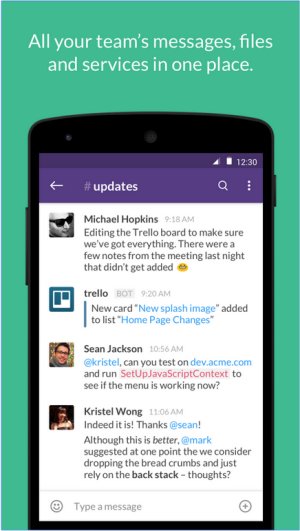Slack has recently released version 4.47.65, continuing its mission to centralize team communications through real-time messaging, file sharing, and various conversation formats. As a highly regarded communication and collaboration tool, Slack helps teams work more efficiently by reducing reliance on email and unifying messaging within a single platform.
At its core, Slack is primarily a messaging app, but its functionality is significantly enhanced by features such as Channels, which categorize conversations by projects, departments, or topics. This organization helps maintain focused discussions, making it easier to locate relevant information. In addition to Channels, Slack offers direct messaging for quick one-on-one or small group conversations, allowing for seamless file sharing and collaboration. Its robust search capabilities enable users to quickly retrieve past messages and files, streamlining workflows.
One of Slack's standout features is its extensive integration ecosystem. The platform allows users to connect with various productivity tools like Google Drive, Trello, Zoom, and Asana, creating a comprehensive hub for collaboration and project management. This interconnectedness transforms Slack from a simple messaging platform into a vital tool for automating tasks and enhancing team productivity.
Key features of Slack include:
- Organized Channels and Direct Messages
- File Sharing capabilities
- Robust Integrations with numerous apps
- Searchable message history
- Automation through Slackbot
- Voice and Video Calling options
Slack offers a free plan that serves as a solid foundation, providing access to 90 days of message history, up to 10 integrations, and one-on-one video calls. However, for businesses that require more advanced functionalities, paid plans like the Pro offer unlimited message history and group video calls. Larger organizations can opt for Business+ and Enterprise Grid plans, which provide additional security and administrative controls.
When compared to competitors like Microsoft Teams and Google Chat, Slack distinguishes itself with its user-friendly interface, ease of use, and adaptability to various workflows. It is particularly beneficial for remote teams where clear communication is essential. Nonetheless, the limitations of the free plan regarding message history and integrations may hinder the growth of expanding teams, while the cost of paid plans can be a consideration for larger organizations.
- User-friendly interface
- Extensive third-party integrations
- Organized Channels for discussions
- Multiplatform support (desktop, mobile, web)
- Searchable message history (available with paid plans)
Cons:
- Free plan limits message history to 90 days
- Potential for distractions due to notifications
- Costs for paid plans can accumulate for larger teams
As Slack evolves, it may continue to introduce features that enhance user experience, further solidifying its position in the competitive landscape of team collaboration tools
At its core, Slack is primarily a messaging app, but its functionality is significantly enhanced by features such as Channels, which categorize conversations by projects, departments, or topics. This organization helps maintain focused discussions, making it easier to locate relevant information. In addition to Channels, Slack offers direct messaging for quick one-on-one or small group conversations, allowing for seamless file sharing and collaboration. Its robust search capabilities enable users to quickly retrieve past messages and files, streamlining workflows.
One of Slack's standout features is its extensive integration ecosystem. The platform allows users to connect with various productivity tools like Google Drive, Trello, Zoom, and Asana, creating a comprehensive hub for collaboration and project management. This interconnectedness transforms Slack from a simple messaging platform into a vital tool for automating tasks and enhancing team productivity.
Key features of Slack include:
- Organized Channels and Direct Messages
- File Sharing capabilities
- Robust Integrations with numerous apps
- Searchable message history
- Automation through Slackbot
- Voice and Video Calling options
Slack offers a free plan that serves as a solid foundation, providing access to 90 days of message history, up to 10 integrations, and one-on-one video calls. However, for businesses that require more advanced functionalities, paid plans like the Pro offer unlimited message history and group video calls. Larger organizations can opt for Business+ and Enterprise Grid plans, which provide additional security and administrative controls.
When compared to competitors like Microsoft Teams and Google Chat, Slack distinguishes itself with its user-friendly interface, ease of use, and adaptability to various workflows. It is particularly beneficial for remote teams where clear communication is essential. Nonetheless, the limitations of the free plan regarding message history and integrations may hinder the growth of expanding teams, while the cost of paid plans can be a consideration for larger organizations.
Pros and Cons:
Pros:- User-friendly interface
- Extensive third-party integrations
- Organized Channels for discussions
- Multiplatform support (desktop, mobile, web)
- Searchable message history (available with paid plans)
Cons:
- Free plan limits message history to 90 days
- Potential for distractions due to notifications
- Costs for paid plans can accumulate for larger teams
Conclusion:
Overall, Slack remains an exceptional solution for enhancing communication and productivity among teams. With its comprehensive feature set, strong integration capabilities, and user-centric design, it continues to be a top choice for modern workplaces. Slack is particularly effective for teams of all sizes looking to streamline communication and consolidate their work tools into a single platform. However, users should consider fine-tuning their notification settings to avoid distractions and assess their budget against the costs of paid plans.As Slack evolves, it may continue to introduce features that enhance user experience, further solidifying its position in the competitive landscape of team collaboration tools
Slack 4.47.65 released
Slack puts all your team communications in one place wherever you go with real-time messaging, file sharing, and one-to-one and group conversations.


